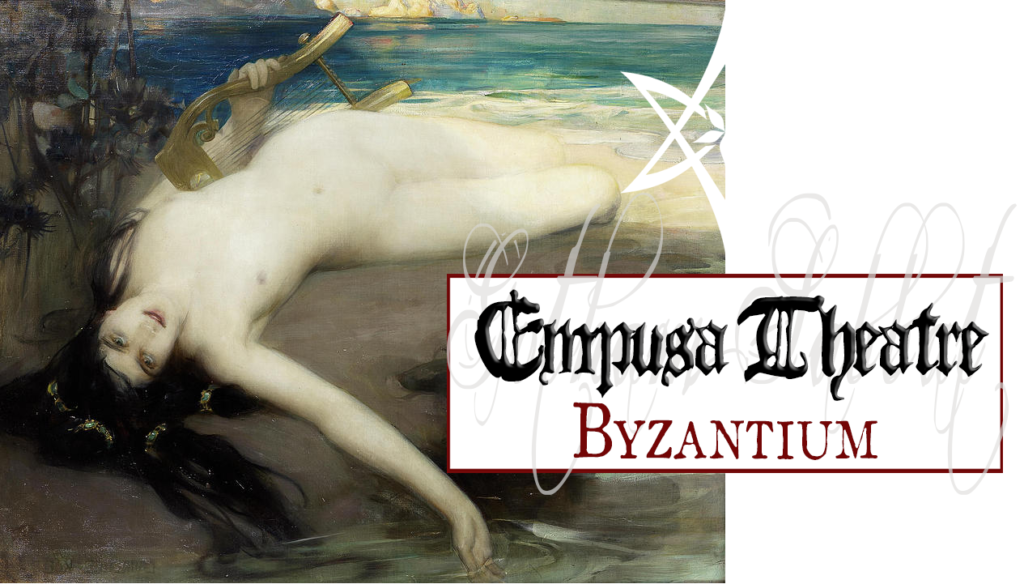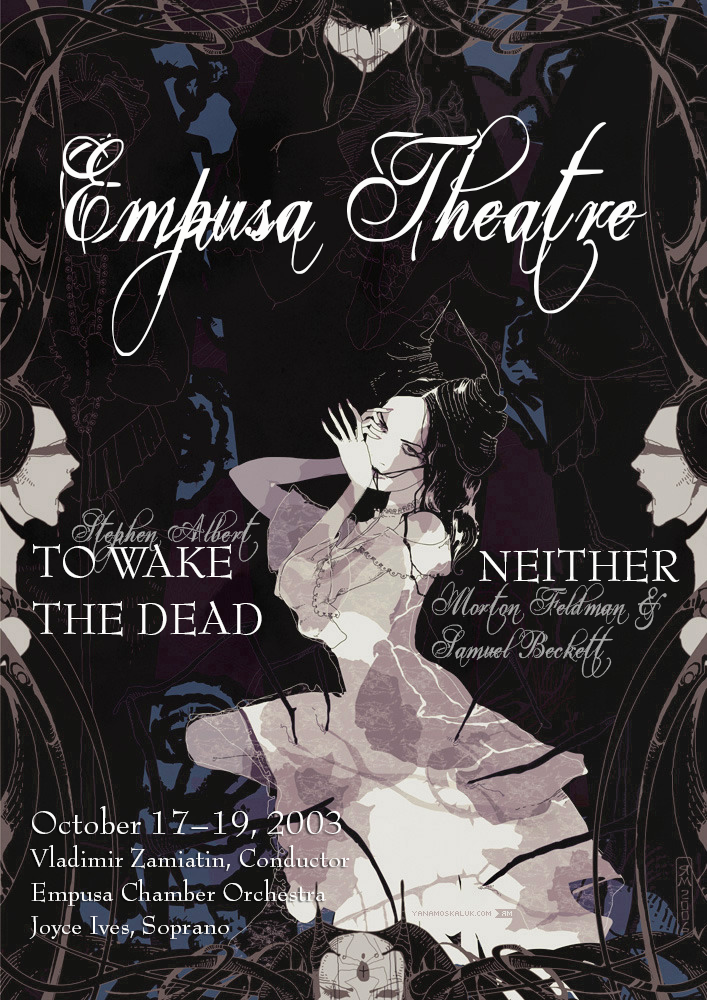Empusa Theatre
- At September 30, 2018
- By Great Quail
- In Vampire
 0
0
I am fond of them, of the inferior beings of the abyss, of those who are full of longing.
—Richard Wagner
Empusa Theatre
In 1989 Calista Joyce purchased the Gotham Lyric Opera near Columbia University and converted it into the Empusa Theatre. Known for its evangelical devotion to avant-garde music, the Empusa has a reputation for outré stagecraft, but is otherwise a completely respectable venue, and is the only “lupanarium” of the Byzantium Coven not dedicated to sex. Modest in size, the theater is decorated in elegant art-nouveau fashion, with marble colonnades and stained glass chandeliers. Its members-only Mormo Salon boasts original paintings by Gustav Klimt and Otto Knille, and the gilded lobby features a bronze statue of Empusa herself, complete with a donkey’s foot of polished brass. The walls are decorated with framed posters of notable Empusa productions, including György Ligeti’s Le Grande Macabre, Jack Beeson’s Lizzy Gordon, and Elliot Carter’s What’s New?
Toreador Elysium
Because of Calista’s unusual history as a Toreador antitribu, the Empusa is frequented by Toreador from both sects, and has emerged as an Elysium for the clan’s divided halves. It is one of the few places that the Toreador of the Sabbat and the Camarilla may collaborate without interference, and while there are certainly some tense moments, several productive partnerships have emerged. Vladimir Zamiatin, Adrienne Tabor, and Amadeus St. Sebastian are particularly fond of the Empusa, and even Veronica Tryst attended the recent revival of The Rape of Salomé, mingling with her former coterie for the first time since her defection in 1916.
The Scandal of The Frogs
The Empusa’s inaugural production was The Frogs, an opera composed in 1967 by the Italian Toreador Luca Inéja. Based on the comedy by Aristophanes, the opera is a strange fusion of Neo-Romanticism with aleatory atonalism, and is renowned for its virtuoso passages of choral music. It featured the début of “Joyce Ives” in the demanding “triple role” of Xanthias, the Empusa, and Charon. The part of Euripides was played by a young Welsh tenor named Rafe Perry, the composer’s clandestine lover and newly-created ghoul. Intoxicated by the wild applause that greeted opening night, Perry demanded to be Embraced once the production was over. The Italian Toreador laughed callously—“One standing ovation does not earn you a place among the immortals.” Infuriated by his lover’s heartlessness, the following night Perry attempted to force his hand. At the height of his mocking duet with Aeschylus—“Oh, what a stroke, won’t you come to the rescue?”—Perry slashed his wrists onstage. Unfortunately for Perry, Inéja did not come to the rescue, and he bled out before the ambulance could arrive.
Well, that’s the official story. In truth, the mortally wounded tenor was beset by a pair of Toreador sopranos from the Frog Chorus, and perished well before Luca Inéja could make it backstage.
The Phantom of the Opera
Whether in spite of the scandal or because of it, The Frogs sold out its remaining nights and was extended for three additional weekends, the role of Euripides assumed by a less volatile tenor. Almost immediately, strange things began to occur backstage—wandering cold spots, sopranos spontaneously losing their voice, mirrors cracking at inopportune moments. It didn’t take long for rumors of an “opera ghost” to circulate, and Ezequiel Pataquiva Santos de Itagüí was summoned to investigate. The Tremere medium took a brief stroll around the theatre and shook his head—“Calista, darling, you have one very angry spirit here. I recommend burning the place to the ground and collecting the insurance money.”
Calista ignored the medium’s advice, and after several unsuccessful exorcisms, the Toreador antitribu resigned herself to grudging coexistence with the spurned lemure. Fortunately, the ghost of Rafe Perry is easily placated, and Empusa regulars have learned to appease the dead tenor with simple offerings—the incessant playing and effusive praise of his sole CD suffices quite well, and the Empusa gift shop never runs out of Rafe Perry Sings! However, sometimes flattery is not enough, and the ghost acts out more aggressively, staging hallucinations, possessing musical instruments, or flooding the floorboards with blood. During such times, Calista brings a blood doll to the theater, a man willing to be possessed by Perry’s spirit for a few hours of carnal pleasures involving melodramatic arias, overpriced champagne, and fucking handsome young tenors. The only time Perry resisted pacification was when Calista foolishly attempted to produce Luca Inéja’s new opera, Benito Cereno. It took several outbreaks of fire and the death of an enghouled countertenor before the production was finally abandoned.
Lupanaria of Byzantium
Club Byzantium | Viriconium | Siddim | The Hippodrome | Zoara Bela | Cabaret Tannhäuser | Empusa Theatre | Hellfire Club | Satrina
Sources & Notes
The core of the Gotham Sabbat was first uploaded on 31 October 2000, but the Byzantium Coven was extensively revised during the August-October 2018 update. The Empusa Theatre is entirely fictional, the product of my desire to remake New York into my own musical paradise. It’s partially inspired by the former avant-garde glories of the Miller Theatre and the New York City Opera, BAM’s “Next Wave” festival, and the outré madness of Barcelona’s La Fura dels Baus and São Paulo’s Teat(r)o Oficina. The painting used for the Empusa Theatre banner is Sappho, by Laurence Koe. The poster for To Wake the Dead/Neither uses a work called Ligeia by the Russian illustrator Yana Moskaluk. Her art is fantastic, sexy, and utterly unique—check it out!
Author: Great Quail
Original Upload: 6 October 2018
Last Modified: 6 October 2018
Email: quail (at) shipwrecklibrary (dot) com
PDF Version: [Coming Soon]


